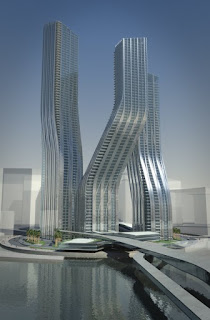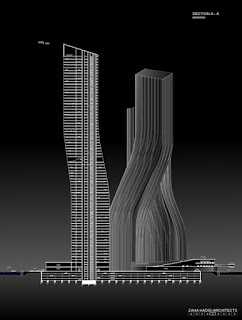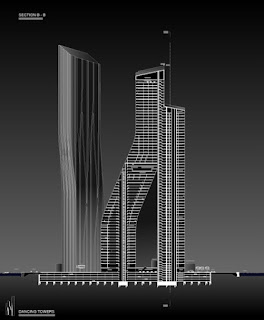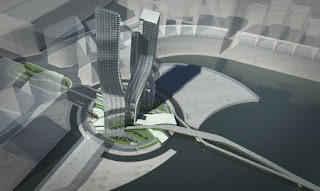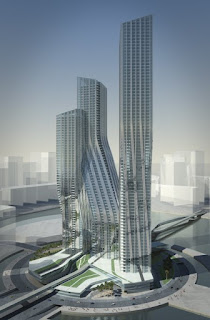When the project is complete it will consist of three interlinking towers containing offices, apartments and a hotel. The Dancing towers, which share a single podium, will form the centrepiece of the Business Bay development Dubai.
Below is a statement from the architect:
Architectural Project Narrative
Designing an Icon
Zaha Hadid's architecture for the Dubai Signature Towers confirms the role of Business Bay Development at the very forefront of Dubai 's rapidly changing future. The Dubai Dancing towers rise above the creek and project themselves as an icon for the surrounding developments and for the gulf region.
The Dubai Dancing tower's striking design creates a new presence that punctures the skyline with a powerful recognizable silhouette. The fluid character of the Dancing towers is generated through an intrinsically dynamic composition of volumes. The Signature towers are inter-twinned to share programmatic elements and rotate to maximize the views from the site towards the creek and neighbouring developments in Dubai.
The design quality of the Dancing towers to act as a symbol and icon extends beyond their scale and location such as Dubai. These qualities are derived from the boldness of the architectural concept, from the 'choreographed' movement that combines the three towers in one overall gesture and 'weaves' with a series of public spaces through the podium, the bridges and the landscape beyond.
Context
There will, in the future, become a silhouette of towers, whose pinnacles will represent the hearts of the new districts within the greater metropolitan area of Dubai .
On the ground, the Dubai Business Bay development site will become stitched into the proposed extended road and infrastructure network of the enlarged metropolitan area. The new pedestrian routes and roads passing under and around the Towers development will extend across the creek, bringing people directly from Sheikh Zayed Road via a grid of major and minor thoroughfares and boulevards.
Connectivity and Public Space
The site is composed by 4 different parts: (A) central circular plot, (B) an elongated park plot, (C) the surface of the creek on axis of plot A and (D) a rectangular plot across the creek at the west margin.
Connectivity between these parts becomes therefore central to the project; in order to produce an articulated design that encompasses both the scale and the different qualities of each of the parts, transforming them into a coherent scheme.
The circular shape of the plot and attached vehicular circulation layout creates a barrier of vehicular traffic around the site, generating an island that detaches the plot from the waterfront promenade.
By incorporating the design of two new link bridges and a new ground the project effectively multiplies the potential and connectivity of the site, linking the park at the East - via the Signature towers with the water's edge at the West margin of the creek.
The site's spectacular location at the waterfront engages the project in the continuous promenade that links through the whole development. By converting the semi-circular road into a tunnel next to the waterfront the proposal releases the ground surface to the pedestrian, significantly enlarging the public space of the promenade. The podium addresses the waterfront by extending it's landscape across and inducing pedestrian movement into the promenade at ground level.
The enclosed bridges allow for people to walk from one point to the other in a comfortable shaded environment. During the summer the bridges would be fully air conditioned. During the winter they would be opened and operate with natural cross ventilation.
The bridge across the creek has a double deck that allows for two different uses: one fast - crossing the creek aided by escalators and travelators, and the other slow with the possibility of having a restaurants and shops on it's wider section. We envisage plot D as a landing building attached to the bridge, programmed with leisure or entertainment activities.
This 'habitable' bridge, with it's prominent location at the centre of the creek' - it's own programme and design - will undoubtedly establish itself as an icon in it's own right: a destination for Dubai , attracting local public and foreign tourists alike.
The bridge to the east, links the park (B) with the retail podium and the Offices' tower. The design of the park carefully knits the built environment with nature. The proposed soft landscape and water features create a more intimate atmosphere, with a terrace of restaurants and bars embedded at the end of the bridge.
The creek waterside promenade and the park promenade address the water elements in two different scales of intervention. The creek public promenade offers the public broad views and vistas. The park provides a more intimate scale surrounded by the trees. The two interventions enrich the overall development by creating a diversity of spaces that allow for multiple uses and different ambiances.
In the proposal a new ground is created with a raised landscape, additional levels that contain programme underneath. Under the great arch formed by the merging of the Residential and the Hotel towers, this canyon - like arch space extends linking the two sides of the site and breaking the perimeter circulation. Arrival at the Hotel drop-off is done under the arch and plaza - townscape, with reception and concierge services, lounge area, as well as bars and restaurants underneath.
This canyon - like space between the towers has a seamless character, connecting the landscape around the podium, with a proposed network of pedestrian paths weaving around the base of the Dubai Dancing towers and the podium various entrances and drop-offs. In the interior, the canyon links the two cores of the Hotel with the podium.
Programme
Programming of public and private life is an active tool to inject life into the space, integrating new layers of activity and landscape, creating a network of synergetic uses that can develop a new urban ecology.
The programme was addressed as a whole with the three Dancing towers corresponding directly to the three main functions: offices, hotel and residential. Together, the towers generate a critical mass of sustainable programmatic relationships.
The Dubai towers share a common base / podium, designed as a materialized shadow of the towers and programmed with retail, restaurants and amenities that support the demand from the tower's population. The podium also contains peripheral functions of the Hotel like the Banquet Hall complex and all the residential car parking.
Under the podium 4 levels of basement accommodate all the necessary heavy back of house / servicing programme, underground technical and plant rooms and car parking for the Retail and Hotel (1st basement) and for the Offices (remaining 3 basements).
The podium terraces / rooftops create outdoor spaces for leisure and recreation, featuring public swimming pools, spa, sports areas and esplanade restaurants. The textured landscape quality of these terraces creates a new ground that interconnects between the towers.
The three towers are conjoined two by two, the Offices and the Hotel at the base and the Hotel and the Residential at the top. Through these adjacencies, the towers are strategically organized in a symbiotic relation, sharing certain segments of the programme.
On the 7th level, the floor plates of the Hotel and the Office towers merge creating a link to the Hotel Business Centre (part of the Offices tower) with meeting rooms, office facilities and services for guests.
The Residential tower shares a core with the hotel, enabling all the back of house / servicing spine to be combined. At 38th level, where the floor plates merge, the apartment residents can share some of the collective programme of the Hotel, like the indoor swimming pool and other amenities.
At the top of the Hotel, 65th Level, the three Signature towers share a panoramic restaurant with breathtaking views over the creek, Business Bay Development area, Burj Dubai downtown, and the Gulf beyond.
The advantage of conjoining the three Dancing towers in one organism, resides in the fact that the development can be lived in a full day cycle: anchored in it's residential population, it reaches the peak of activity during office hours and it mutates through the diversity of the ever-changing population of the hotel.
In Dubai, The heterogeneous population mix creates a cosmopolitan urban environment, constantly energized and renovated through it's own life








